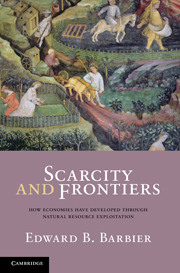Book contents
- Frontmatter
- Contents
- Figures
- Tables
- Boxes
- Preface
- Acknowledgements
- 1 Introduction: scarcity and frontiers
- 2 The Agricultural Transition (from 10,000 BC to 3000 BC)
- 3 The Rise of Cities (from 3000 BC to 1000 AD)
- 4 The Emergence of the World Economy (from 1000 to 1500)
- 5 Global Frontiers and the Rise of Western Europe (from 1500 to 1914)
- 6 The Atlantic Economy Triangular Trade (from 1500 to 1860)
- 7 The Golden Age of Resource-Based Development (from 1870 to 1914)
- 8 The Age of Dislocation (from 1914 to 1950)
- 9 The Contemporary Era (from 1950 to the present)
- 10 Epilogue: the Age of Ecological Scarcity?
- Index
- References
9 - The Contemporary Era (from 1950 to the present)
Published online by Cambridge University Press: 05 June 2012
- Frontmatter
- Contents
- Figures
- Tables
- Boxes
- Preface
- Acknowledgements
- 1 Introduction: scarcity and frontiers
- 2 The Agricultural Transition (from 10,000 BC to 3000 BC)
- 3 The Rise of Cities (from 3000 BC to 1000 AD)
- 4 The Emergence of the World Economy (from 1000 to 1500)
- 5 Global Frontiers and the Rise of Western Europe (from 1500 to 1914)
- 6 The Atlantic Economy Triangular Trade (from 1500 to 1860)
- 7 The Golden Age of Resource-Based Development (from 1870 to 1914)
- 8 The Age of Dislocation (from 1914 to 1950)
- 9 The Contemporary Era (from 1950 to the present)
- 10 Epilogue: the Age of Ecological Scarcity?
- Index
- References
Summary
It appears that poorer countries with static comparative advantages in (non-oil) primary commodities, or in low-tech manufactures, would be well advised to try to create different and more dynamic comparative advantages in higher-tech manufactures or services. Otherwise, they may well be caught in the trap of deteriorating terms of trade and may be at the wrong end of the distribution of gains from trade and investment. Hence our conclusion emphasizes the importance of education, and development of skills and of technological capacity. In the light of recent mainstream thinking on growth and trade, there is nothing startling about this conclusion.
(Raffer and Singer 2001, p. 25)… there is no iron law associating natural resource abundance with national industrial strength.
(Wright 1990, p. 666)Introduction
As we saw in the previous chapter, by 1950 two important global trends in resource-based development had emerged. First, industrial development and rapid growth had become dependent on expanding the knowledge, expertise and industries to exploit global frontiers of fossil fuels, minerals and iron ores. No matter how well endowed an economy was with its own natural resources, exploitation of vertical frontiers had become a global phenomenon, and increasingly the new sources of mineral wealth were located in the underdeveloped periphery of the world economy. Second, although the expansion of horizontal frontiers of land and agriculture was no longer the primary means through which countries attained economic and military superiority, frontier land expansion was still an important mechanism for absorbing the world’s rural poor. But industrialized economies that had achieved take-off into sustained growth did not require this outlet. Instead, frontier land expansion as a means to absorb surplus labor – especially on marginal lands in fragile environments – became largely a symptom of “underdevelopment” in the poorest economies of the world.
The Contemporary Era, from 1950 to the present, has therefore witnessed an unprecedented global exploitation of both vertical and horizontal frontiers, with much of this expansion occurring in the developing regions of the world. Moreover, as in the previous era of globalization, during the Golden Age of Resource-Based Development from 1870 to 1914, worldwide resource expansion and exploitation occurred during an age in which international trade was booming and primary-product commodities were increasingly consumed by the advanced and rapidly industrializing economies of the world. Just as in past decades, most low- and lower-middle-income countries during the Contemporary Era appear to rely on finding new sources of natural resources and land to exploit as the basis of their long-term development efforts. Agricultural land expansion and natural resource exploitation are fundamental features of economic development in many of today’s poorer economies.
- Type
- Chapter
- Information
- Scarcity and FrontiersHow Economies Have Developed Through Natural Resource Exploitation, pp. 552 - 662Publisher: Cambridge University PressPrint publication year: 2010



